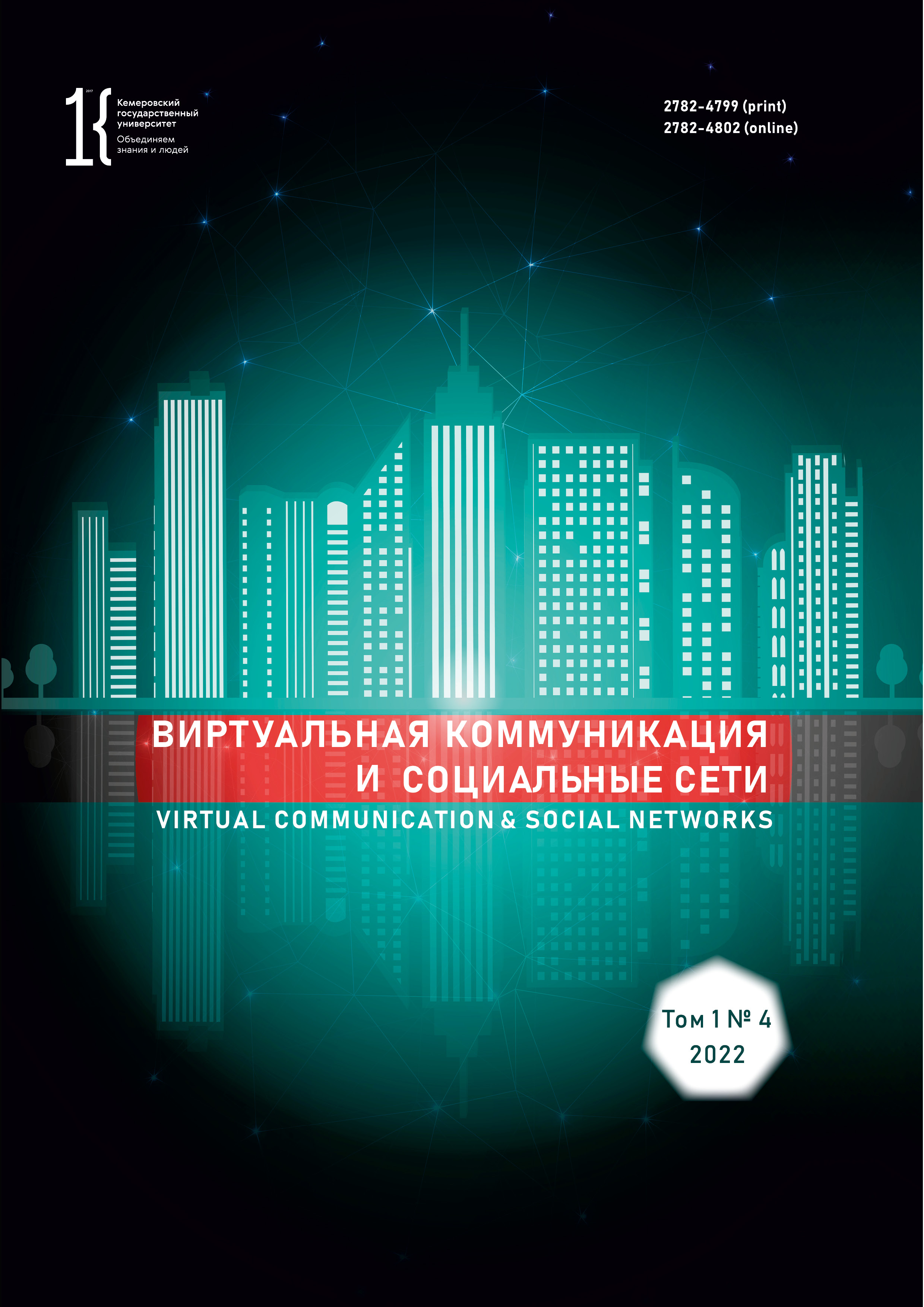Krasnodar, Russian Federation
Krasnodar, Russian Federation
This research tested a complex analytical method based on semantic modeling of discursive fields and network analysis that can be applied to networked linguistic data. The copyright software package Monitoring and Analysis of Social Networks, Internet Communities, and Users provided automatic data processing to restore the semantic core of the discursive fields generated by Typical Krasnodar and Typical Kemerovo online communities in 2021–2022. The analysis was visualized as social graphs and semantic core models. It identified a number of sensitive topics that generated a lot of feedback. The method also proved efficient in predicting cultural and socio-political trends. The complex methodology provided rapid identification of amplified discursive activity, conditions for social unrest, and bifurcation points for destructive social practices. The results may contribute to effective information management and social strain relief in the regions through discursive control of online communication.
discursive fields, online communities, semantic core, network linguistics, social media, VKontakte, network linguistic data
1. Gnedash A. A. The fourth wave of feminism: political discourse and opinion leaders in Twitter. RUDN Journal of Political Science, 2022, (24): 64-89. (In Russ.) https://doi.org/10.22363/2313-1438-2022-24-1-64-89
2. Ryabchenko N. A., Gnedash A. A., Malysheva O. P., Katermina V. V. Managing political content in the online space of modern states: how Twitter prevented D. Trump from winning the 2020 presidential election? Political science, 2021, (4): 135-160. (In Russ.) https://doi.org/10.31249/poln/2021.04.06
3. Ryabchenko N. A., Malysheva O. P., Katermina V. V., Gnedash A. A. Communication model "Speaker-Listener" in the context of digitalization of the linguistic turn: experience of network and linguodiscursive analysis of YouTube content. Political Linguistics, 2021, (1): 81-94. (In Russ.) https://doi.org/10.26170/1999-2629_2021_01_07
4. Aaditi K. A Study about Influence of Social Media in Agriculture Marketing with reference to India. Advances in Management, 2020, 13(4): 50-65.
5. Chen B., Zhu X., Shui H. Socio-semantic network motifs framework for discourse analysis. LAK22: 12th International Learning Analytics and Knowledge Conference, 2022, 500-506. https://doi.org/10.1145/3506860.3506893
6. Chomsky N. Syntactic Structures. Berlin, N. Y.: Mouton de Gruyter, 2002. https://doi.org/10.1515/9783110218329
7. Ji S., Pan S., Cambria E., Marttinen P., Philip S. Y. A survey on knowledge graphs: representation, acquisition, and applications. IEEE Transactions on Neural Networks and Learning Systems, 2021, 33(2): 494-514. https://doi.org/10.1109/TNNLS.2021.3070843
8. Kalantari K. E., Frrokhi B. M. H., Ghonchepour M. A Critical discourse analysis of Trump’s tweets based on Van Dijk model. Journal of Zabanpazhuhi, 2020, 12(34): 155-156.
9. Leong C., Pan S. L., Bahri S., Fauzi A. Social media empowerment in social movements: power activation and power accrual in digital activism. European Journal of Information Systems, 2019, 28(2): 173-204. https://doi.org/10.1080/0960085X.2018.1512944
10. Manganello J. A., Chiang S. C., Cowlin H., Kearney M. D., Massey P. M. HPV and COVID-19 vaccines: social media use, confidence, and intentions among parents living in different community types in the United States. Journal of Behavioral Medicine, 2022, 17(15): 1-17. https://doi.org/10.1007/s10865-022-00316-3
11. McDonald N., Forte A. Powerful privacy norms in social network discourse. Proceedings of the ACM on Human-Computer Interaction, 2021, 5(CSCW2): 1-27. https://doi.org/10.1145/3479565
12. Papatzani E. Encountering everyday racist practices: sociospatial negotiations of immigrant settlement in Athens, Greece. International journal of urban and regional research, 2021, 45(1): 61-79. https://doi.org/10.1111/1468-2427.12984
13. Pasta S. Social network conversations with young authors of online hate speech against migrants. Cyberhate in the Context of Migrations. Palgrave Macmillan: Cham, 2022, 187-214. https://doi.org/10.1007/978-3-030-92103-3_8
14. Ryabchenko N. A., Gnedash A. A., Malysheva O. P., Shestakova A. A., Nikolaeva M. V. Socio-political content and regional discourse of modern Russia: the issues discussed by citizens in the online space and the solutions offered by the candidates for governor in their election manifestos (intersection points and fault lines). South Russian Journal of Social Sciences, 2019, 20(4): 27-48.
15. Tesnière L. Elements of structural syntax. Amsterdam & Philadelphia, PA: John Benjamins, 2015, 780.
16. Wagner C. J., González-Howard M. Studying discourse as social interaction: the potential of social network analysis for discourse studies. Educational Researcher, 2018, 47(6): 375-383. https://doi.org/10.3102/0013189X18777741
17. Wu D. D., Li C. Emotional branding on social media: a cross-cultural discourse analysis of global brands on Twitter and Weibo. Intercultural Communication in Asia. Education, language and values, eds. Curtis A., Sussex R. Springer, 2018, 225-240. https://doi.org/10.1007/978-3-319-69995-0_11
18. Zhang J., Featherstone J. D., Calabrese C., Wojcieszak M. Effects of fact-checking social media vaccine misinformation on attitudes toward vaccines. Preventive Medicine, 2021, 145. https://doi.org/10.1016/j.ypmed.2020.106408















